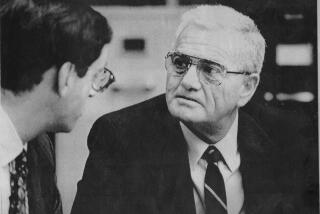BOOK REVIEW / MEMOIRS : On Genetics, Personal Anguish and a Cruel Disease Called Huntington’s : MAPPING FATE: A Memoir of Family, Risk and Genetic Research, <i> by Alice Wexler</i> , Times Books/Random House, $23,320 pages
- Share via
The further I read in this remarkable memoir, the more often I turned back to examine the photo on the book jacket: There, in the center of the 1940s snapshot, stands Leonore Sabin Wexler, beside her two small daughters, Alice and Nancy.
Even as she stood there, Leonore was on the brink of a chasm into which she would slip gradually, but inexorably, until her death 30 years later on Mother’s Day, 1978.
The chasm was Huntington’s disease (named after New York Dr. George Huntington, who identified it, in 1872, as hereditary in families). When Leonore’s condition was revealed to the Wexler sisters in 1968, they learned that all of their paternal uncles and a maternal grandfather had died from the disease. They also learned that each of them stood a 50-50 chance of having inherited Huntington’s.
Huntington’s is a cruel disease that attacks the brain and leads to palsy, mental illness and sometimes insanity. Symptoms do not appear in most people until sufferers are past 40 and often already parents. Until the Wexlers began speaking out, the best-known patient of Huntington’s was folk singer Woody Guthrie.
By the time Alice was 9, the Wexlers had moved from the East Coast to Los Angeles, where her father, Milton, opened a practice in clinical psychology. Alice, now a historian and biographer, remembers her mother then as housebound, quiet and withdrawn until divorce and the onset of the full-blown disease robbed her of whatever self-confidence remained. Alice describes in painful detail her mother’s long decline and death.
She also describes her own search, even before her mother’s death, for the vibrant, witty, intelligent woman her father married. That woman, a budding biologist, had studied with geneticist Thomas Hunt Morgan, spent a summer doing research at Wood’s Hole in Massachusetts, and knew the names of myriad insects. She searched for the mother she never knew, all the while mourning the sad afflicted invalid who, when she was still young, had lost the opportunity to grow older with grace.
“Mapping Fate” is also about Alice’s father, who in realizing the desperate truth of the situation, rallied friends and colleagues with the daughters he adores into creating the Hereditary Disease Foundation. Alice delineates his personal conflicts, as well as her own tangled relations with him.
*
One way of appreciating “Mapping Fate” is for Alice’s understanding that you can accept and love parents, even when you believe that you would not have acted as they did in the same circumstances. Another way is for her account of sisters loving and supporting each other as they struggle, alone, to confront fate.
“Mapping Fate” is rich beyond what could be expected in 202 pages of text for its details of medical sleuthing. Nancy Wexler worked in Venezuela among a village of people suffering from all stages of Huntington’s. With their cooperation, her team was able to chart the inherited pattern of the disease. Eventually the gene itself was located.
DNA studies are usually conclusive, but seldom simple to explain (as demonstrated by expert testimony in courts of law). Alice Wexler has managed to explain the genetics of Huntington’s and its inheritable pattern as clearly as it has ever been done.
Moving rapidly from triumph to triumph, Alice leaves us where she and Nancy are now. They can each find out if they will develop the disease. But bad as it is living with the possibility of the disease, living with the certainty may be worse. What if one sister has the gene and not the other?
Finding genetic markers is the first step in the battle against incurable hereditary conditions. The next step is prevention and treatment, perhaps by genetic engineering. But for Huntington’s that is still far in the future. Having participated in the science itself does not mean that the Wexler sisters will have themselves tested. That is their decision--one that ought never be coerced.
A valuable primer in medical ethics, human genetics, personal growth and even literary style, “Mapping Fate” captures both the personal anguish and lifelong ramifications of a hereditary disease.
More to Read
Sign up for our Book Club newsletter
Get the latest news, events and more from the Los Angeles Times Book Club, and help us get L.A. reading and talking.
You may occasionally receive promotional content from the Los Angeles Times.










